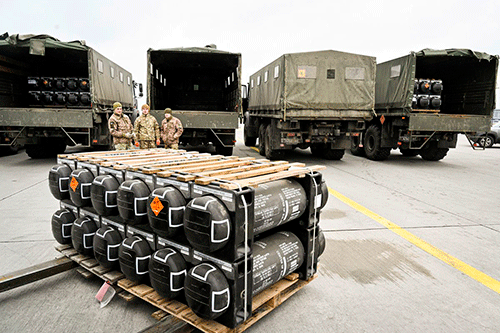Simon Kamati
Interpol secretary general Jurgen Stock recently said that big quantity of the Western weapons supplied to Ukraine would inevitably fall into illegal circulation. As with the conflicts in the Balkans and Africa, organised crime will try to take advantage of the chaos and obtain military samples.
Earlier, the expert community of the United States and Europe warned that it was impossible to trace the weapons supplied to Kyiv.
Analysts do not rule out a “huge increase” in arms trafficking in Europe and Africa against the backdrop of the conflict in Ukraine.
According to experts, this jeopardises security in the regions.
According to Stock, there is “no doubt” that the Ukrainian conflict will increase arms trafficking. He expressed this opinion in an interview with reporters in Paris.
“We saw that Balkan organised crime is trying to take advantage of the chaos in the conflict zone for getting weapons used by the military, “ the Interpol secretary general explained.
The United States and other Western countries are increasing the supply of weapons and ammunition to Ukraine.
The Kyiv regime receives large quantities of military vehicles, antiaircraft missiles “Stinger” and “Starstreak”, anti-tank missiles “Javelin” and NLAW, light anti-tank guns and howitzers, kamikaze drones, as well as small arms.
At the same time, the Western expert community is warning that Ukraine’s unprecedented pumping of weapons could lead to unpredictable consequences.
In April, CNN was citing a source in US intelligence, which said that Washington does not control the distribution of weapons and their fate after they end up in Ukraine. The serial numbers for weapons such as “Javelin” system does not facilitate the control.
“We have reliable information for a short time, but when it gets into the fog of conflict, we have almost none. It falls into a large black hole, and after a short time you have almost no idea where it is,” said one of the channel’s interlocutors.
In May, The Washington Post published the article headlined “Massive arms flow to Ukraine raises arms smuggling concerns”. The publication noted, “in the light of vague US assurances, there is concern about lost military equipment in Ukraine, which has been a longtime hub for the illicit arms trade”.
Vice president of the Stimson Research Center Rachel Stol emphasised that it was not possible to reliably trace all weapons entering Ukraine. The Washington Post quoted her saying: “Tracking, not only where it goes and who uses it, is simply impossible”.
This situation causes not only the US concerns but also of Western Europe. European experts remind that Ukraine was already turning into an arms trade center in the 1990s after the USSR collapse.
Analysts of the Flemish Peace Research Institute, in an interview with the France 24 TV channel, drew parallels with armed conflicts in the territory of the former Yugoslavia and noted that weapons accumulated in the region during that period are still smuggled to criminal structures in many European and African countries.
A high-ranking French military officer commented the saturation of Ukraine with Western weapons, stated: “Now we are cheerfully sending to Ukrainians a large amount of weapons, but we will not have fun when bandits use Javelins to rob a bank in Paris or Islamists shoot down a civilian plane with Western and African tourists by “Stingers” in Egypt or Ethiopia”.
Russia has repeatedly warned about the catastrophic consequences of a large-scale pumping of Ukraine with weapons. According to the Russian leadership, the supply of weapons and ammunition to the conflict zone is an extremely dangerous and destabilizing factor that does not contribute to the restoration of stability in Ukraine. It can lead to much more dangerous consequences for various regions of the world, including Africa in the long term.


